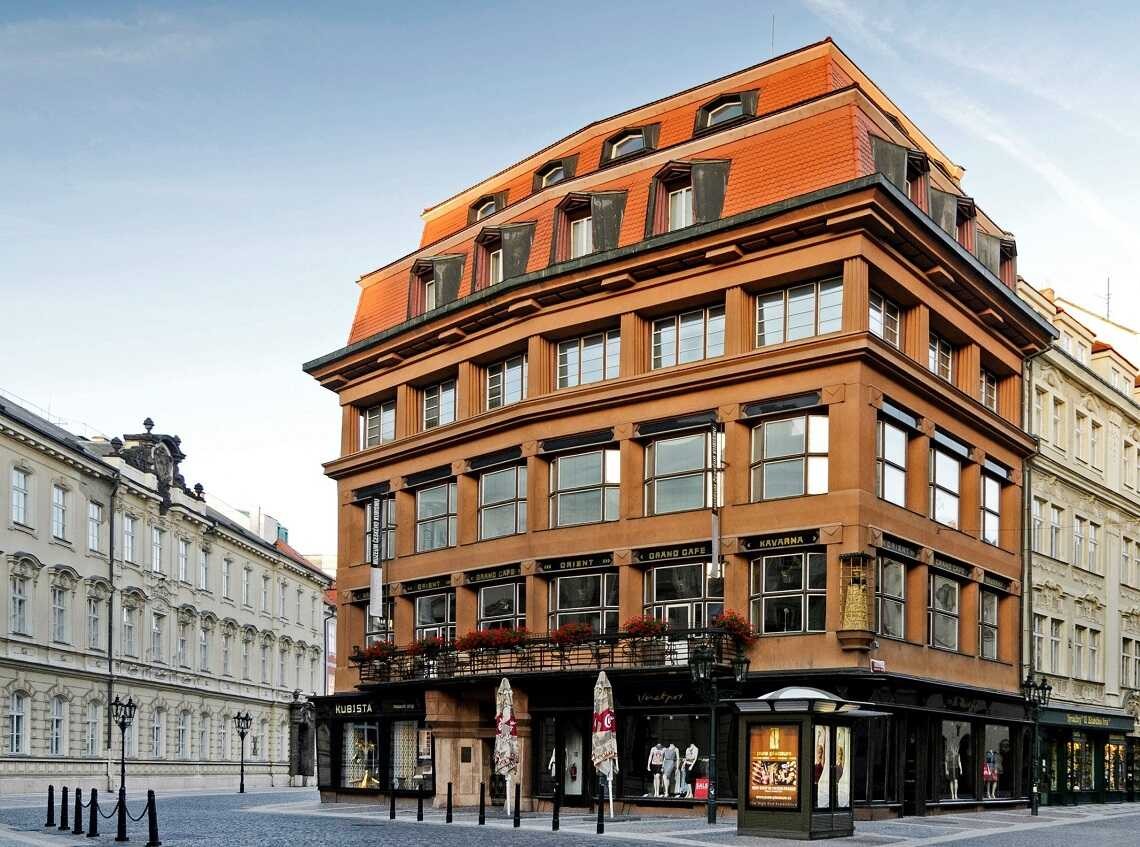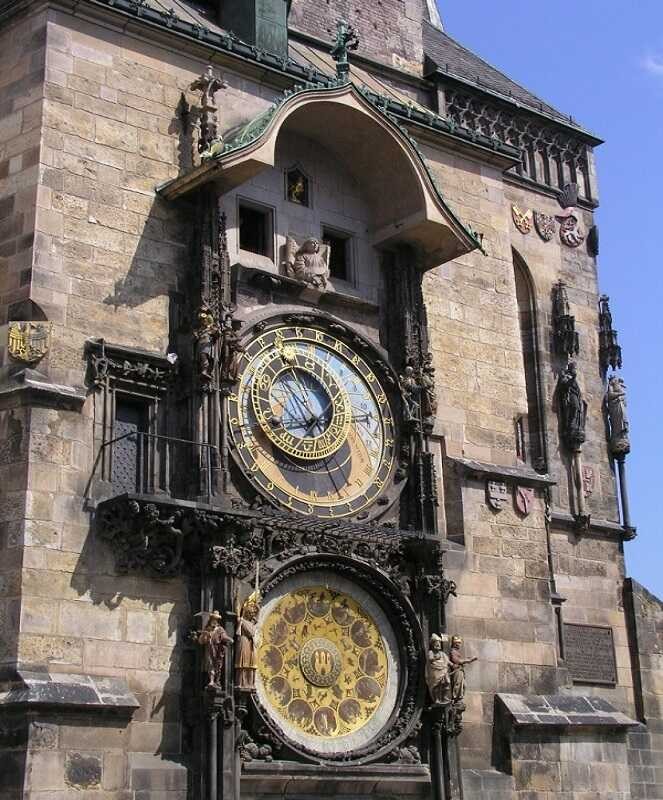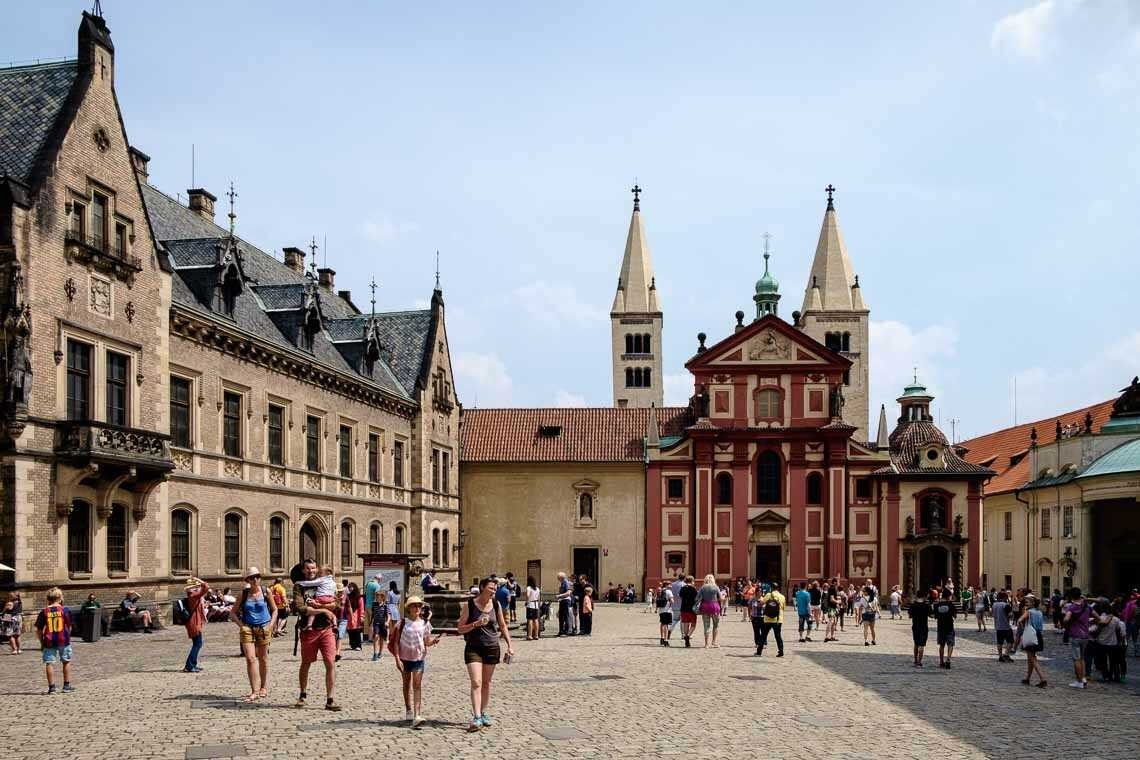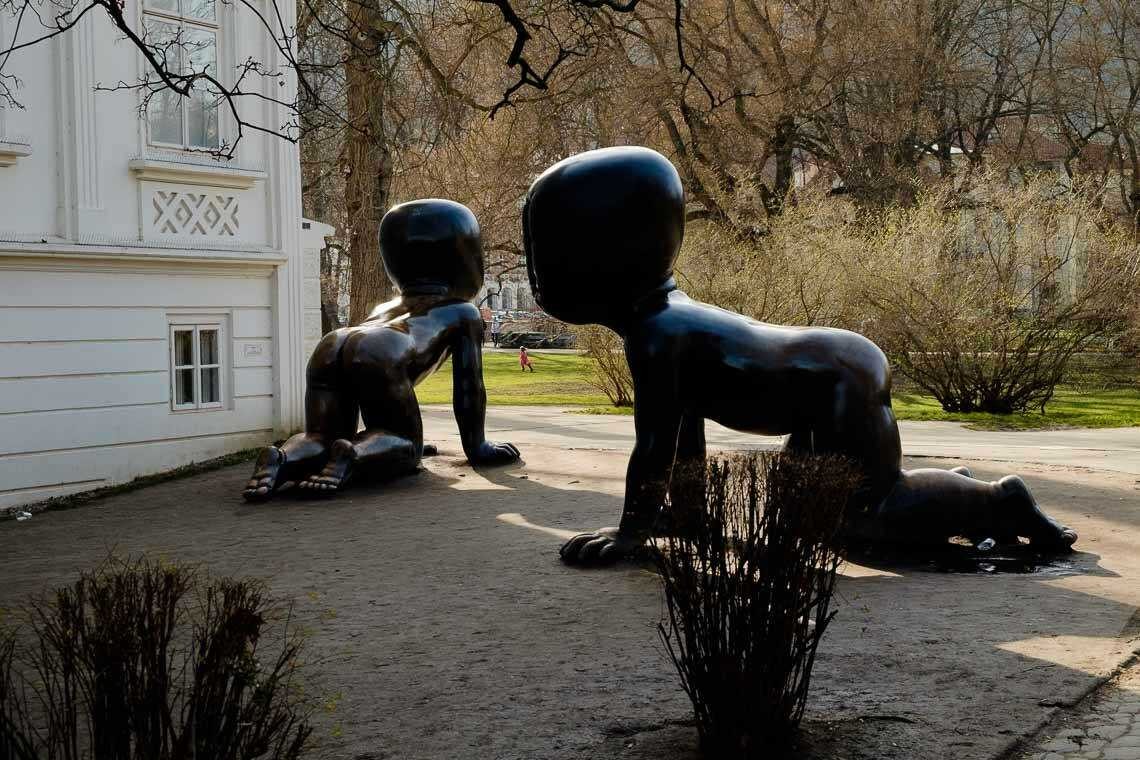THROUGH THE OLD & LESSER TOWN TO THE PRAGUE CASTLE
Walk around the places that every tourist wants to visit. As a bonus we have included a few hidden gems - overlooked alleys of the Old Town and the beautiful views of Petrin hill.
4 hours net walking time, 7-8 hours in very leisurely pace with stops
10 Km
During this walk you will visit:
- The Old Town & the Old Town Square
- The Charles bridge
- The Prague Castle
- Petřín hill
 Download: THROUGH THE OLD & LESSER TOWN TO THE PRAGUE CASTLE.pdf
Download: THROUGH THE OLD & LESSER TOWN TO THE PRAGUE CASTLE.pdf
From the hotel´s door go to the left, on the first crossroad turn right to Opatovická street, which is heading left after 100 meters. A church of St. Michael´s will be on your left.
St. Michael´s church
Originally, Romanesque church from the early 12th century. The church has been rebuilt over the centuries. Firstly, in Gothic and then in a Baroque style. Later, Gothic style was restored again. Its current form is a mix of different architectural styles. Construction of the church was limited by proximity of the street. For this reason, the church has an irregular floor plan.
From the church continue straight on Opatovicka street. Turn right to Ostrovní, cross Spálená st. and continue straight ahead. Pass by the shopping mall Quadrio. Behind it you will see the statue of Franz Kafka´s Head.

Franz Kafka´s statue
Franz Kafka´s head
A giant masterpiece (11 meters, 39 tonnes) by the controversial Czech artist David Cerny located behind the shopping centre Quadrio at Narodni Trida. Kafka´s head consists of 42 levels, which gradually rotates around a central axis.
Continue straight (the statue is on your left) to Charvátova street which ends as a short passage. Go through the passage, cross Národní street and enter the courtyard of Platýz Palace, that will be just in front of you. Leave the courtyard by narrow passage on your left and you will get in front of the church of St. Martin in the Wall.
 Church of St. Martin in the wall
Church of St. Martin in the wall
Church of St. Martin in the wall
Originally a Romanesque church. During the construction of the wall around the Old Town in the 13th century was located in close proximity to walls, hence the nickname "in the wall" in the name of the church. The church was rebuilt in the 14th century in Gothic style. The church was disestablished and converted into a residential house in the 18th century. It serves again as a church since the 20th century. Notice the stone gargoyle on the roof of the church that is linked to a legend of a petrified disobedient boy.
Continue right (the church is behind you) to Uhelný trh. Pass the square crosswise around a fountain and get into V Kotcích street. At the end turn left and followed by right turn. Walk around a church of St. Havel from its left side. Turn left and after few steps right into a narrow Kamzíkova street. It ends with a passage which leads to Celetná street. Turn right and after 150 m you will see a House at the Black Madonna on your right.
 House of the Black Madonna
House of the Black Madonna
House of the Black Madonna
Prague's first cubist building designed by architect Josef Gočár in 1912 - originally served as a department store. In the European context, the Czech Cubist architecture has a unique position. The house was named after the statue of the Black Madonna, which is positioned at the front of the house and was transferred from the original baroque palace.
Nowadays, you can find a café on the 1st floor Grand Café Orient. It´s cubist interior was recently renovated. Café opening hours: MON-FRI 9am – 10pm, SAT-SUN 10am– 10pm.
2nd and 3rd floor hosts an exhibition of the Czech Cubism Museum of Art. Opening hours: Tuesday - Sunday: 10am – 6pm 150 CZK.
 Grand Café Orient
Grand Café Orient
Enter the passage of Bernad Bolzano on the left side of Celetná street opposite the House at the Black Madonna. Turn left to Štupartská street that will lead you to a back wing of the Týn church. Go around the church from the right. Alternatively turn right at the beginning of Štupartská to Malá Štupartská street and after 30 m turn left into a courtyard called Ungelt. Cross Ungelt and get to a back wing of the Týn church. TIP: An entrance to the Týn church is from the Old Town Square no. 14. If you want to visit Týn Literary Café, get through a passage to Týnská street. The café is after 50 m on the right side.
 The Old Town Hall and Týn Church
The Old Town Hall and Týn Church
Church of Our Lady before Týn (Týn church)
Artistically very significant gothic sacral building that is a prominent feature of the Old Town.
Construction of aisled basilica took place from the mid-14th century to the early 16th century. Matthias of Arras and Peter Parler participated on the construction. The impressive vault in the main nave reaches a height of 30 meters. The towers are 80 meters high. The interior is decorated with works of major artists of the Czech Baroque - e.g. Karel Škréta. In the church, you can see the tombstone of the astronomer Tycho Brahe. The church is open from Tuesday to Saturday from 10am to 1pm and from 3pm to 5pm, on Sunday from 10am to noon, and is closed on Mondays. Admission is voluntary.
TIP: Have a coffee in Týn Literary Café that is very popular among students due to a pleasant atmosphere and low prices.
Use the narrow lane on your right to pass around the Tyn Church and you will reach the Old Town square. The Old Town Hall is directly in front of you.

The Prague Astronomical clock
The Prague Astronomical clock (Orloj)
Medieval astronomical clock from the early 15th century, located in the tower of the Old Town Hall is one of the most popular tourist sights in Prague. When the clock strikes the hour (from 9am to 9pm), the procession of the Twelve Apostles and other figures on the astronomical clock are set in motion. The performance is completed with gilded rooster crowing.
The Old Town Hall tower offers an epic view of the whole Prague. The tower is open daily from 9am to 10pm, on Monday from 10am to 10pm hours. Admission is 130 CZK. To avoid crowds of tourists, it´s better to come either in the morning or late in the evening.
TIP: Buy electronic mTicket on prague.mobiletickets.cz or by scanning the QR code at the Old Town Hall - it is cheaper (110 CZK) and you do not have to wait in a queue.
From the Old Town Hall go straight (the Old Town Hall is on your right) to Malé náměstí. Pass the square crosswise and turn left to Linhartská street. It leads to Mariánské náměstí. Pass the square crosswise and get into courtyard of the Klementinum.
 Baroque Library Hall
Baroque Library Hall
Clementinum - Library and Tower
Klementinum is an extensive Baroque complex creating an oasis of calm in the bustling city centre. The complex was built in the mid-16th century and originally served as a Jesuit college. Since 1622 until today it houses a library. The dominant feature is 68 meters high astronomical tower, which is open to the public and offers a great view. Since the mid-18th century meteorological measurements have been carried-out, one of the oldest continuous measurements in the world. Guided tours of Klementinum (Baroque Library Hall, Astronomical Tower, Meridian Hall) are daily from 10am every 30 minutes. Admission is 220 CZK.
 Epic view from Astronomical Tower of Klementinum
Epic view from Astronomical Tower of Klementinum
Leave the Klementinum using the south passage (the nearest exit) to Karlova street. Turn right and continue straight to the Charles bridge. Cross the bridge to the Lesser Town. If you are already tired, you can make a shortcut: from Mostecká street turn left to Lázeňská. At its end turn left to Velkopřevorské náměstí, where´s the Lennon´s wall. With this shortcut you will miss the Prague Castle and Petřín hill, which you could alternatively visit another time.
 Charles bridge and Prague Castle from the Old Town bridge tower.
Charles bridge and Prague Castle from the Old Town bridge tower.
Charles bridge
The bridge was built between 1357-1402 during the reign of Charles IV. It is one the most popular and famous sights in Prague. Charles Bridge is 516 meters long and connects the Old Town with the Lesser Town. Baroque statues by Czech artists Matthias Bernard Braun and Ferdinand Maxmilian Brokoff are on the bridge from the 17th century. Neoclassical statues of Joseph and Emanuel Max's were added in the 19th century.
Legend about the Charles bridge
Near the statue of St. John of Nepomuk is a sacred place with a bronze cross on a stone railing. According to legend, it will grant a wish when you touch the cross.
It is said that eggs were added into mortar during the construction of the bridge. This theory has recently been refuted. On the other hand, the research discovered that wine and milk were added into mortar.
TIP: To take nice photos of/from the Charles Bridge we suggest to get up early the early morning. Because the bridge is completely filled during the day and at night. Good news – our hotel is only 10 minutes walking distance.
The Old Town bridge tower and the Lesser Town bridge Tower
Both towers are opened to the public daily from 10am -6pm (November-February), from 10am – 8pm (March-October) & from 10am-10pm (April – September). Admission fee is 90 CZK.
TIP: The bridge towers are not often visited by tourist. Therefore, it is an ideal place to take original photos of picturesque Prague.
From the Charles bridge continue straight ahead towards the Lesser Town Square (Malostranské náměstí). Walk around the baroque church of the St. Nicholas from the left. Behind the church turn right. Pass the square crosswise to a narrow Zámecká street. It leads you to a beginning of the New Castle Stairs (Nové zámecké schody). Climb up the stairs to Hradčanské náměstí and the gate of the Prague Castle.

St. Vitus Cathedral
Prague Castle
The castle is one of the World´s largest castle complexes. It was founded in the 9th century and since then it became a seat of Czech rulers and presidents.
The castle complex is daily open to public free of charge 6am-10pm.
Due to security check at the entrance to the Prague castle complex, a short delay can be expected.
Tickets to access Castle buildings can be bought at the 2nd courtyard in an information centre, 3rd courtyard (information centre opposite an entrance to St. Vitus Cathedral), Golden Lane, Daliborka or at the Old Royal Palace. Tickets are valid for two days.
Two different circuits are available:Circuit A (Old Royal Palace, the Story of Prague Castle, St. George´s Basilica, Golden Lane, Powder Tower, St. Vitus Cathedral, Rosenberg Palace) for CZK 350;
Circuit B (Old Royal Palace, St. George´s Basilica, Golden Lane, St. Vitus) for 250 CZK.
St. Vitus Cathedral
It located on the 3rd courtyard of Prague Castle and it is the most important religious building in the Czech Republic. It was the seat of the Bishop of Prague since the 10th century, and later it became seat of archbishop. Construction of the cathedral began in 1344 on the initiative of Emperor Charles IV. Festive completion of the construction took place in 1929. Construction of the cathedral took almost 600 years. Therefore, all architectural styles influenced the Cathedral. Gothic and Pseudo-Gothic styles are the most represented architectural styles. Many artistic monuments from different historical periods are in the Cathedral. Prominent personalities of Czech and European history (archbishops, kings and emperors) were buried here. The most important place of the cathedral is St. Wenceslas Chapel, which was built as a reliquary housing and where the crown jewels of Czech kings are kept. The cathedral is open to the public Mon-Sat from 9am to 5pm, Sunday from 12to 5pm (April to October), until 4pm in the period from November to March.
The vestibule of the cathedral can be visited free of charge. If you wish to see the entire cathedral you need a ticket. Ticket can be purchased opposite of the entrance to the cathedral in the information centre. Tickets cannot be purchased separately. Cathedral can be visited only with Circuit tickets.
 St. George´s Basilica
St. George´s Basilica
St. George´s Basilica
The oldest building at the Prague Castle. The history of this church dates back to the year 920, when the original church was founded. The adjacent Benedictine monastery was built during 10th century. The church was rebuilt several times. Nowadays, the basilica is predominantly in the Romanesque style, in addition to the early Baroque facade from the first half of 18th century. Church towers are called Adam and Eve and they are 43 meters high. Tomb of St. Ludmila, the patron saint of the Czech state is in the basilica.
Should you wish to visit the basilica you need to buy a ticket. Tickets cannot be purchased separately. Basilica can be visited only with Circuit tickets. The nearest ticket office is in the Old Royal Palace.
 Golden Lane
Golden Lane
Golden Lane
Picturesque alley formed by quaint houses with low roofs, tiny windows and doors. Development placed between the northern wall of the fortifications and the Old Burgrave emerged from the mid-15th century as dwellings for the castle marksmen, later inhabitants serving the castle. The houses were inhabited until 1948. Colourful facade was designed by the Czech artist Jiri Trnka.
To enter the Golden Lane, you need a ticket that cannot be bought separately. The Golden Lane can be visited only with Circuit tickets. The nearest ticket office is at the entrance to the Golden lane.
 Hradčanské square
Hradčanské square
From the gate walk up on the left side of the square to Loretánská street. On your left you will pass a restaurant “A divadlo pokračuje (U zavěšenýho kafe)”, where you can have a lunch for reasonable price.
Once you pass the restaurant you will see narrow staircase on your left. Walk down the stairs and turn right to Úvoz street. Turn left on the path leading to the park. If you want to visit Strahov monastery or a luxurious Bella-Vista restaurant turn right and go up the hill towards the monastery. Otherwise, continue through the park to Petřín hill via Petřín lookout tower. Follow the signs “Rozhledna”.
 Strahov Monastery
Strahov Monastery
Strahov Monastery
A Premonstratensian monastery founded in 1140 was in its time the largest Romanesque building in Bohemia and soon became the center of medieval scholarship. The monastery was reconstructed in early Gothic and late Renaissance style. The most visible influence had the baroque style. The relics of St. Norbert can be found at The Church of the Assumption of the Blessed Virgin Mary. St. Norbert was the founder of the Premonstratensian order.
The monastery complex contains also the Strahov Library (open daily 9am-12, 1pm-5pm, admission 100 CZK) and the Strahov Gallery (open daily 9:30am -11:30am, 12-5pm, admission 120 CZK).
TIP: The beautiful view can be enjoyed from a viewing point that is located south of the convent building. To get there follow the signs "socha Panny Marie z exilu" from a path bellow the monastery.
 Prague Castle and Lesser Town from Petřín hill
Prague Castle and Lesser Town from Petřín hill
 Petrin Lookout Tower
Petrin Lookout Tower
Petrin Lookout Tower
The design of Petrin lookout tower was inspired by famous Eiffel Tower in Paris. It was built in 1891 and the construction took only 4 months. It is located at the top of Petrin hill and offers splendid views of the city. The top of the tower can be reached via 299 steps.
Open daily 10am - 6pm (November to February), from 10am to 8pm (March, October) from 10am to 10pm (April to September). Admission is 120 CZK.
.
From the lookout tower continue 120 m to a Mirror Maze.

Mirror Maze on Petřín hill
Mirror Maze on Petřín hill
The maze was created from 38 mirrors. It is situated in the building that copies a Gothic Gate „Špička“. It used to be the gate to the Vyšehrad Castle until the half of 17th century. A torso of the gate can be seen during the Vyšehrad walk.
From the Mirror Maze follow the signs „lanovka“ to the station of the funicular. Use the funicular to get down the Petřín hill. Of course you can walk down the hill.
 Rose garden on Petřín hill
Rose garden on Petřín hill
Rose garden
If you visit Prague in the summer, then you should visit the Rose Garden at the top of Petrin hill. With its 8,000 roses is the largest rose garden in Prague. Blooming roses can be admired from early June until the first frost. The Rose Garden is located at the top of Petrin funicular station.

Petrin Funicular
Petrin Funicular
The upper lift station is located in the Rose Garden at the top of Petrin hill. The base is near the tram stop Ujezd. It operates daily 9pm to 11:20 p.m. in 15 minute intervals (November to March) or in 10 minutes intervals (April to October). During regular inspections in the spring and autumn the lift is out of operation. Public transportation tickets are accepted.
TIP:Enjoy beautiful views from the funicular and from Nebozízek.
The track is 510 meters long and overcomes the difference in altitude of 130 meters. The funicular was put into operation in 1891 and was originally water-powered, it was electrified in 1931.
TIP: Should you fancy great Italian ice cream we can highly recommend Angelato. Located opposite the stairs to the park where the base is (Ujezd 24). Attention! It is closed in January and February. Otherwise, it is open daily 11am to 9pm (10pm) hours.
From the base climb down the stairs to Újezd street, turn left and walk 380 m. Turn right to Harantova street. At its end turn left to Maltézské náměstí, then right and right again to Lázeňská street that steers left to Velkopřevorské náměstí.
 John Lennon´s Wall
John Lennon´s Wall
John Lennon´s Wall
During 1960´s the stone wall surrounding the Maltese Gardens was transformed into memorial with paintings of the singer's face and quotes from his songs as well as with poetry and protest slogans against totalitarian regime.
From the John Lennon´s Wall continue across a small bridge over channel called Čertovka.

Čertovka
Čertovka
Prague's picturesque corner formed around 740 meters long channel of the Vltava river. The channel separates the island Kampa
From the John Lennon´s Wall continue across a small bridge over channel called Čertovka. Behind the bridge turn right and then left at the end of the street. Enter the Kampa park. On the left side of the park you will see a Sova´s Mills gallery.
 Sova´s Mills
Sova´s Mills
Sova´s Mills - Museum Kampa
History of mills at Kampa dates back to the 10th century and is connected with a series of fires and floods. Last time the building was significantly damaged during the floods in 2002. Today's appearance of Sova´s Mills was created by linking the New Renaissance style from the second half of the 19th century and modern architecture from the reconstruction in 2000 - 2001.
Foundation of Jan and Meda Mládek manages the museum. The museum has an extensive collection of Central European Modern art, especially works of the painter Frantisek Kupka and the cubist sculptor Otto Gufreunda.
 Babies from David Černý at Kampa
Babies from David Černý at Kampa
From Sova´s Mills walk upstream the Vltava river until you leave the park. Climb up the stairs and get onto the bridge. Cross the bridge walking towards the National Theatre.
 National Theatre from Kampa
National Theatre from Kampa
National Theatre
A neo-renaissance building built in 19th century by architect Josef Zítek. The theatre and its building played a very important role in the Czech national history during the 19th century. Nowadays it consists of three ensembles: opera, ballet and drama.
The nearest way from the National Theatre to the hotel Páv leads through the old and new theatre building. Cross the square, walk down the stairs and turn left to Ostrovní street. Turn first right to Pštrossova street, first left to V Jirchářích street and then right to Křemencova street. The hotel Páv will be on your right.
 en
en cs
cs de
de fr
fr es
es it
it pl
pl ru
ru